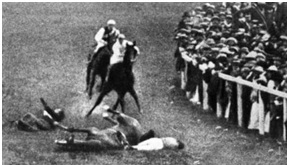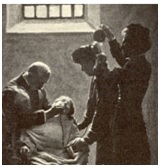|
 |
|
 |
Emily Davison’s Death at the English Derby - Suffragettes and Women's Rights
Emily Davison’s death at the English Derby (1913) Famous for... Emily Davison (a suffragette) walking in front of... King George V’s horse, Anmer, at the... English Derby on June 4th 1913 (at Epsom, near London, pictured above). She died in hospital on June 8th.
Who were the suffragettes? Led by Emmeline Pankhurst (pictured right) their aim was to win the vote for women through violent action like
Emily Davison (pictured right in May 1913) joined them in 1906 and became its most fanatical supporter. British women were then:
Thousands of suffragettes escorted Emily’s coffin through London before it boarded a train for the funeral at her home town of Morpeth in Northumbria in northern England, where she is buried.
Did she intend to kill herself?
The evidence is inconclusive.
Evidence against suicide is:
1. She bought a return railway ticket to the Epsom racecourse.
2. Two suffragette flags were pinned to her jacket indicating her intention was only to pin a flag to the king's horse.
3. Perhaps only imprisonment was on her mind - she was carrying letters, envelopes and stamps that she would need to write home from prison.
Arguments for suicide are:
1. Emily had attempted suicide in 1912 by throwing herself down an iron staircase in Holloway prison in protest against her force feeding (see the next section).
2. Emily (pictured right) wrote in an article that the
suffragette cause needed the: “last consummate sacrifice of a militant”.
3. Emily was depressed, unemployed and short of money.
4. Emmeline Pankhurst wrote in a book how Emily believed that: “the conscience of the people would awaken only to a sacrifice of human life”.
5. The New York Times wrote that a spectator near to Emily said: “Her conduct was that of a mad woman. It looked almost as though she was seeking death”.
Why were the suffragettes force fed? They went on hunger strike in prison. Pipes were forced down their throats to feed them, so they wouldn’t die (pictured right). Emily was:
She committed a crime and then always gave herself up.
Emily’s main offences
1910 Broke a window in the House of Commons.
1911 Set fire to pillar (or mail) boxes. 1912 Whipped a Baptist minister whom she mistook for the Chancellor of the Exchequer, David Lloyd George (pictured right).
1913 Planted a bomb at Lloyd George’s half built (and so empty) house, severely damaging it.
Did Emily’s death help women?
Probably not. Emmeline Pankhurst’s organization, the Women’s Social and Political Union (WSPU),, which Emily supported, became very unpopular because of its campaign of increased violence from late 1911 onwards. The WSPU:
Many women opposed violence including Emily’s distraught mother who wrote to her just before she died: “I cannot believe that you could have done such a dreadful act”. Emily was completely forgotten in 1914 on the outbreak of World War One. This did more than anything to give women the vote, because they:
Women over 30 got the vote in 1918. Those over 21 had to wait until 1928.
What happened to the horse and jockey? The king’s horse that killed Emily, Anmer, and its jockey, Herbert Jones (pictured right), recovered from their injuries. But Jones:
In June 1928 he went to Emmeline Pankhurst’s funeral, laying a wreath that read: “To do honour to the memory of Mrs. Pankhurst and Miss Emily Davison”.
Who won the race?
Aboyeur after the favourite, Craganour, was disqualified. Most of the 60,000 crowd were so engrossed in the race that they were totally unaware of Emily’s accident.
Key quotes
Deeds not words. - the suffragettes’ slogan (written on Emily Davison’s gravestone).
Rebellion against tyrants is obedience to God. - Emily Davison’s favourite phrase (which she wrote on the walls of Holloway prison).
|
|
|
||
|
|
|
||
|
||
| Copyright © wisdomtowin.com All Rights Reserved | ||
|









